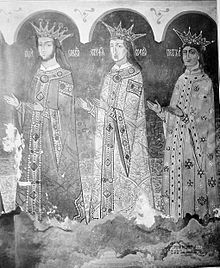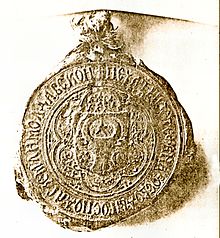Stefan IV. (Moldova)
Stefan IV , also Stefan the Younger , mostly Romanian: Ștefăniță , also Ștefan Vodă cel Tânăr , (* 1506 - 14 January 1527 in Hotin ) was Prince of Moldova from 1517 to 1527. After the death of his father Bogdan III. he ascended the throne at the age of only eleven.
biography
Since the grandson of Ștefan cel Mare was still a minor when he ascended the throne on April 20, 1517, the country was ruled by the Moldovan Diwan, headed by the Supreme Army Commander (Portar de Suceava) Luca Arbore. The latter also took care of the boy's upbringing and was his most important advisor. The boy spent a lot of time traveling to Poland , Germany , the Crimea and Constantinople . In addition to Latin and Romanian, he also spoke German, Polish, Turkish, Greek, and even Armenian and Tatar. At an early age he devoted himself to trading in precious stones, which made him a fortune.
Hardly in power, Ștefăniță first concluded an economic and assistance pact in Krakow on March 9, 1518, and shortly afterwards, on May 4, in Hârlău, a peace and assistance agreement with the Poles, which the Ottomans put against him. As a result, fell in the same year the Tartars entered into the land but were also with Polish support, the governor of Lower Vltava (vornic de Ţara de Jos) Petrea Cărăbăţul on August 8, 1518 at Ciuhru near the market Şerbanca the Prut devastating beaten. Only a few enemies survived, most of them drowned in their haphazard escape across the Dniester .
A few years later, the good relations with the northern neighbors were broken. In 1522 King Sigismund I refused the very precocious voivod's request for the hand of one of his daughters. The latter also increasingly surrounded himself with new, Turkish-friendly advisers, snubbed the dignitaries who were once loyal to his father and grandfather, and sometimes harassed them to such an extent that some sought protection in Poland, which prompted the young people to complain to the Polish court. Luca Arbore, the aged hetman and mentor of the prince, wished for fear of the Turks, especially after the fall of Belgrade in 1521, to continue close relations with Poland and therefore made contact with the Polish royal court. However, the despot accused him of having met with the exiled boyars and the king with the aim of eliminating him and installing his uncle Petru Rareș on the throne, which is historically incorrect. Without further ado, Stefan had Arbore executed without trial or evidence in April 1523 and his innocent sons Toader and Nichita murdered. Only his six daughters, all of whom were married to high-ranking boyars, survived. As a result, numerous nobles, beginning on September 7, 1524, rose against Stefan, but the uprising was bloodily suppressed with the support of incited hordes of farmers and many officials were killed; many more fled to Poland.
Shortly thereafter, Stefan was to marry Ruxanda, daughter of the late Prince Neagoe Basarab , but she preferred to marry the new lord of the country, Radu de la Afumați († 1529), on January 26, 1526. However, he initially refused to marry Stana († February 1531), another daughter of Neago. Therefore, out of injured pride, he waged a successful but pointless war with Wallachia . Eventually he agreed to marry Stana.
The prince defeated the army of Tassa-Pascha, which had invaded Poland and pushed back into the Moldau, and made rich booty. But he could neither lessen the deep diplomatic tensions he had caused with the Poles, nor the hatred of numerous boyars for his outrageous deeds. In order to get rid of the tyrant, probably on behalf of Poland, he was poisoned with the knowledge of his own wife and many boyars during one of his extravagant revels and died without a legitimate successor. According to Ureche even Stana is said to have personally poisoned her husband. The chronicler Grigore Ureche (1590–1647) reported something similar. He is buried in Putna Monastery .
Ștefănițăs life was the basis on which Barbu Ștefănescu Delavrancea wrote his drama Viforul . Likewise, George Coşbuc settled in Ștefăniță-Vodă from his volume of poems Fire de tort (1896) with him.
See also
Individual evidence
- ↑ Ion Ionascu, Dr. Petre Bărbulescu, Gheorghe Gheorghe: "Tratatele internaționale ale României, 1354-1920: texte rezumate, adnotări, bibliografie", Editura Științifică și Enciclopedică, Bucharest 1975, pp. 72, 499
- ↑ Ștefan cel Tânăr ( Memento of the original from April 2, 2015 in the Internet Archive ) Info: The archive link was inserted automatically and has not yet been checked. Please check the original and archive link according to the instructions and then remove this notice. , P. 522
- ↑ Ion Țurcanu: "Istoria românilor: Cu o privire mai largă asupra culturii române", Editura Istoros, Brăila 2007, p. 74
- ↑ Grigore Ureche: “Letopisețul țărâi Moldovei, de când s-au descălecat țara”, Volume I, Bucharest 1987, p. 153
- ↑ a b Moldovenii
- ^ Ion Nistor: "Istoria Basarabiei", Editura Humanitas, Bucharest 1991, p. 72
literature
- Manfred Stoy: Ştefăniţă , in: Biographical Lexicon for the History of Southeast Europe . Vol. 4. Munich 1981, p. 193 f. (Retrieval date)
- Ștefan cel Tânăr, in Romanian
| personal data | |
|---|---|
| SURNAME | Stefan IV. |
| ALTERNATIVE NAMES | Stefan the Younger; Ștefăniță; Ştefan Vodă cel Tânăr; Stefan IV of Moldova (official name) |
| BRIEF DESCRIPTION | Voivode of the Principality of Moldova |
| DATE OF BIRTH | 1506 |
| DATE OF DEATH | January 14, 1527 |
| Place of death | Hotin |


